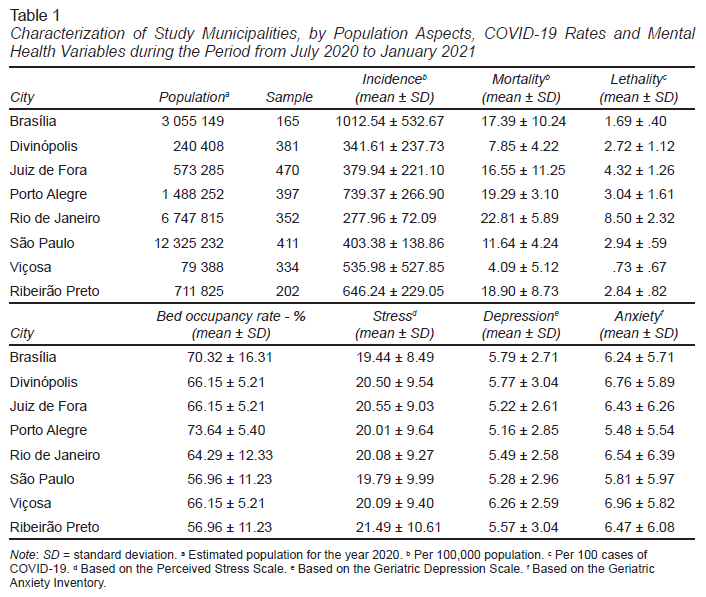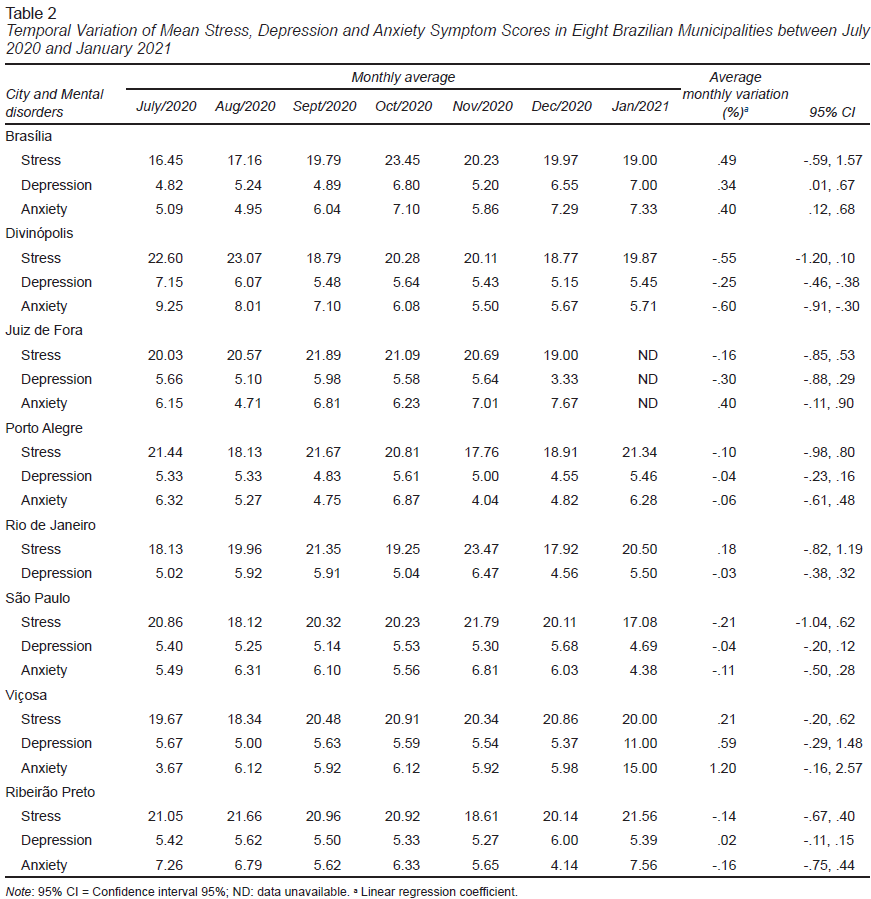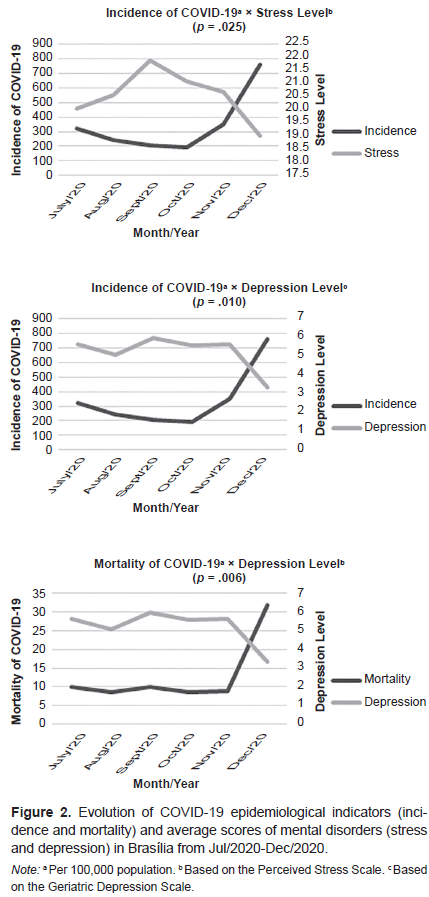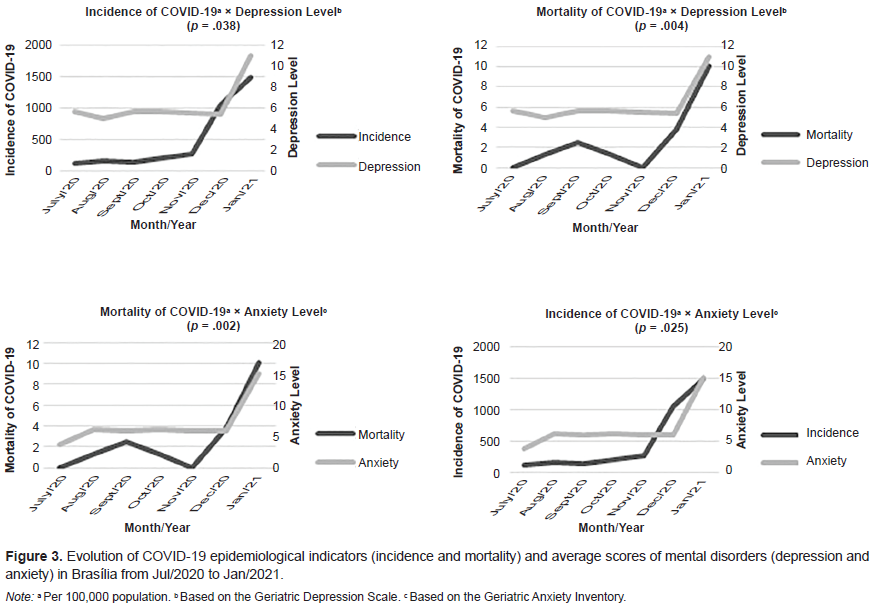INTRODUCTION
The emergence of the new coronavirus (SARS-Cov-2) and the 2019 coronavirus disease (COVID-19) pandemic have highlighted the potential impact public health problems can have on people’s well-being. In addition to the repercussions on physical health, the process of spreading the infection also resulted in psychosocial, economic, political, environmental and other social consequences (Hossain et al., 2020; Hosseinzadeh et al., 2022; Rasheed et al., 2021).
The population only had a short period of time to absorb and understand the scope of the problem, in addition to having to abruptly adapt and adjust their lifestyle (Balanzá-Martínez et al., 2021; Di Renzo et al., 2020). It was necessary to respond to several challenges, such as social distancing and isolation, mask wearing and hand hygiene, in a context of uncertainty about COVID-19, high infectivity, lack of vaccines and definitive treatment, overload of health systems, recession and unemployment (Dubey et al., 2020; Werneck & Carvalho, 2020; Xiong et al., 2020).
Given all the changes and repercussions, the mental health of the population was also expected to be affected, a phenomenon described as the “fourth wave of care,” encompassing the mental and emotional changes resulting from the pandemic (Pedreira Massa, 2020). For 2020 alone, a study published in The Lancet estimated a 27.6% increase in major depressive disorder cases worldwide, and an additional 25.6% of anxiety disorder cases (COVID-19 Mental Disorders Collaborators, 2021). Another survey showed that stress was the most prevalent mental health consequence in China during the initial pandemic period, affecting approximately 48.1% of the population (Bareeqa et al., 2021).
Of all the age groups, the older adult population was regarded as one of the most susceptible to the psychosocial impacts resulting from the pandemic (Armitage & Nellums, 2020). This is thought to be due to several factors, including the fact that older adults are vulnerable to developing complications from COVID-19, leading to significant fear in this group (Dubey et al., 2020). In addition, this group is more susceptible to psychiatric disorders (Machado et al., 2016; Silva et al., 2018), regardless of other factors, and the pandemic may exacerbate existing mental health problems.
Despite the progress to date, studies correlating statistics on the occurrence of COVID-19 with anxiety, depression and stress levels in older adults are as yet incipient. A review of the literature on the subject showed that several studies were able to demonstrate the prevalence of an array of symptoms and mental disorders in the population aged 60 and over (Bohlken et al., 2021; Das et al., 2021; Jemal et al., 2021; Kurniawidjaja et al., 2022; Srifuengfung et al., 2021). However, no details were found on the behavior of mental health variables over time associated with epidemiological rates related to the pandemic.
In this respect, this study proposes to evaluate screening for stress, depression and anxiety symptoms during the months of the evolution of the COVID-19 pandemic and their relationship with measures of the occurrence and severity of the disease (incidence rates, lethality, mortality and/or occupation of ICU beds) in older adults from eight Brazilian cities.
METHOD
The present study is part of the research project entitled “The COVID-19 infodemic and its repercussions on the mental health of the elderly: a multicenter study Brazil/Portugal/Spain/Italy/Chile” (Aguiar et al., 2022; Bezerra Cavalcante et al., 2022; Fhon et al., 2022; Kitamura et al., 2022; Santos et al., 2022). This research consists of an ecological, time-series study analyzing data from eight Brazilian cities (Juiz de Fora-MG, Divinópolis-MG, Viçosa-MG, Rio de Janeiro-RJ, Ribeirão Preto-SP, São Paulo-SP, Porto Alegre-RS, Brasília-DF), collection from July 2020 to January 2021.
Subjects/sample description
The study population consisted of older adults (aged 60 years or over) with access to e-mail and/or social networks and/or a smart phone. Older adults who did not agree to participate in the study or were unable to answer the questions autonomously were excluded.
The sample size of the multicenter study was estimated by city, considering the older adult population with internet access, using the formula: n = N.Z².p.(1-p)/Z².p.(1-p). + e².(N-1), where “n” is the calculated sample, “N” is the population, “Z” the standardized normal variable associated with the confidence level, “p” the true likelihood of the event (P = (1-P) = .5, assumption of maximum variation), and “e” the sampling error, using a sampling error of 5% and a confidence level of 95%. Thus, in Brazil, for each city mentioned above, the inclusion of 330 to 384 older adults (aged 60 years or over) was estimated. Although two municipalities failed to reach the indicated sample, they were maintained in the present study for the sake of representativeness (Ribeirão Preto and Brasília). In total, 2,712 older adults were interviewed. Sampling was non-probabilistic.
Procedure
Data collection was conducted between July 2020 and January 2021, using a web-based survey. It was sent (in three batches over a three-month period), initially to groups of older adults with access to e-mail and/or social networks already followed by researchers in other outreach and research activities unrelated to mental health in each collaborating center of the study (community and senior support groups). Telephone contact was also used as a complementary strategy for inviting people to participate and clarifying doubts regarding the answers to the web-based survey. Older adults who received the links were asked to forward them to potential participants in their circle of acquaintances. Data collection was therefore based on the technique known as a “virtual snowball,” which has increasingly been used in quantitative studies, with large sample numbers and inaccessible populations (Costa, 2018). It should be noted that during the COVID-19 pandemic, social distancing was recommended as a protective measure for older adults, with emphasis being placed on importance of their staying at home.
Seeking a more representative sample, as a complementary measure, the link to access the web-based survey was also forwarded to scientific geriatrics and gerontology societies, institutions caring for older adults and retiree associations.
When accessing the link, older adults were initially directed to the digital Free and Informed Consent Form (TCLE), which they were asked to read before deciding whether or not to participate in the study. Their decision was automatically registered in the database generated by the web-based survey. Only older adults who had agreed to participate in the study had access to the web-based survey questions. The form had no spaces to register participants’ names, thereby guaranteeing their anonymity. In addition, codenames were used for the interviewees to replace their e-mails and phone numbers.
Measurements
For the construction of the questionnaire and data collection, the Google Forms tool, a file storage and synchronization service, was chosen because it is free, in the public domain and easy to access and manage for both researchers and respondents. This data collection system did not permit the generation of duplicate responses by email and/or telephone, making it possible to manage data duplication.
Screening for stress, depression and anxiety symptoms was performed using the Perceived Stress Scale-PSS (Cohen et al., 1983), Geriatric Depression Scale-GDS (Yesavage et al., 1982) and Geriatric Anxiety Inventory-GAI (Pachana et al., 2007), respectively. In Brazil, the PSS was translated and validated by Luft et al. (2007). The GDS was validated by Paradela et al. (2005) and its reliability analyzed by Almeida & Almeida (1999). The GAI was translated and adapted into Brazilian Portuguese by Martiny et al., (2011) and the validation study was conducted by Massena (2014). The three scales demonstrated good psychometric properties with the population studied. The monthly mean scores for each scale and in each city were regarded as aggregated variables for data analysis.
Demographic data and variables regarding the occurrence and severity of COVID-19 were collected on the websites of the Ministry of Health (Ministério da Saúde, n.d.), the Oswaldo Cruz Foundation-Fiocruz (FIOCRUZ, 2020) and the Brazilian Institute of Geography and Statistics-IBGE (IBGE, 2020). The following data were collected for each municipality: population size, monthly number of COVID-19 cases and deaths, and ICU bed occupancy rate for COVID-19. From these data, the incidence, mortality and lethality rates of COVID-19 were calculated in each municipality studied.
Statistical analysis
Stress, depression and anxiety scale and temporal variation estimate scores were analyzed using descriptive statistics (mean and standard deviation) and a simple linear regression model, with scores being interpreted as the outcome and the month as the explanatory variable. Trends toward increase, decline, or stagnation were expressed as the β coefficient of monthly variation, with the respective 95% confidence interval (CI) to assess the accuracy and statistical significance of temporal variations. Trends with a regression coefficient not different from zero were considered stationary.
Correlation tests (Pearson or Spearman—according to data normality) were performed to explore the association between the variables of occurrence and severity of COVID-19 (incidence rates, mortality, lethality and occupancy of COVID-19 ICU beds) and variables related to the mental health of older adults (scores on the stress, depression and anxiety scales). All data were analyzed using the Statistical Package for Social Sciences 21.0 software, with a significance level of 5%.
Ethical considerations
In accordance with Resolution 466/2012 of the National Health Council, which provides for research with human beings, the project was submitted for consideration by the National Research Ethics Committee (CONEP) and approved in July 2020 (Opinion No. 4.134. 050). Subjects who agreed to participate in the research were asked to sign the TCLE. Thus, all participants were respected in terms of their dignity and autonomy, recognizing their vulnerability, making sure of their willingness to contribute and ability to decide whether or not to remain in the research project in a free and informed manner.
RESULTS
Population data, measures of the occurrence and severity of COVID-19 and the mental health variables of the municipalities are shown in Table 1. High incidence rates of COVID-19 were observed in all municipalities (over 250 cases per 100,000 population) during the study period. Higher mortality rates were observed in Rio de Janeiro and Porto Alegre, followed by Ribeirão Preto, Brasília and Juiz de Fora; the other municipalities had fewer than 12 deaths per 100,000 population. The highest fatality rate was found in Rio de Janeiro, while Viçosa had the lowest incidence of deaths per 100 confirmed cases of COVID-19. In regard to the bed occupancy rate, all municipalities were classified as having a medium alert level (between 50 and 80% occupancy) during most of the period analyzed.
Mean scores on the stress, depression, and anxiety scales are relatively homogeneous. The highest stress index was observed in Ribeirão Preto, and the lowest in Brasília. In regard to the depression and anxiety scales, Viçosa had the highest and Porto Alegre the lowest values (Table 1).
Table 2 shows the mean scores of the stress, depression and anxiety scales for each municipality between July 2020 and January 2021, in addition to the mean monthly variation and the respective confidence interval. All municipalities displayed occurrence data throughout the study period, except for Juiz de Fora, where there was no data collection in January 2021.
In regard to the depression and anxiety scales, only Brasília showed a significant upward trend over time, while Divinópolis was the only municipality with a significant downward trend. No trend was observed in the stress scale during this period in any municipality (Table 2).
Figures 1, 2 and 3 show the rates of occurrence and severity of COVID-19 and the average scores of mental disorders in some of the municipalities evaluated during the study period. In the city of Brasília (Figure 1), there was a negative correlation between the incidence of COVID-19 and stress (p = .026) and anxiety (p = .041), and between mortality and anxiety (p = .30). In Juiz de Fora (Figure 2), negative correlations were also observed between the incidence of COVID-19 and stress (p = .025) and depression (p = .010), in addition to a correlation between mortality and depression (p = .006).
In Viçosa (Figure 3), positive correlations were observed between the incidence of COVID-19 and depression (p = .038) and anxiety (p = .025), and between mortality and depression (p = .004) and anxiety (p = .002). In the other municipalities, there was no statistically significant correlation between the variables studied.
DISCUSSION AND CONCLUSION
The results observed allow a partial understanding of the epidemiological patterns of COVID-19 in the population and of mental disorders in older adults during the pandemic. Throughout the period studied, a scenario of high rates of infection by the new coronavirus was observed, in addition to fluctuations in stress, depression and anxiety levels. An upward trend in anxiety and depression was observed in the city of Brasília, whereas in Divinópolis, a downward trend was observed in the mental health variables mentioned above.
The study also allowed the analysis of correlations between levels of mental disorders and measures of occurrence and severity of COVID-19. Negative correlations were found in Brasília and Juiz de Fora, since stress, depression and anxiety levels behaved in the opposite direction to incidence and mortality rates for the new coronavirus. At the same time, positive correlations were observed in the municipality of Viçosa, where anxiety and depression levels followed the same pattern as incidence and mortality rates.
In Brasilia, it was found that, despite the drop in incidence and mortality rates, stress and anxiety levels increased over the period studied. One of the hypotheses for this scenario is the fact that the municipality implemented an early easing of quarantine restrictions compared to other cities, with the reopening of bars, gyms and other businesses as early as July 2020 (Valente, 2020), which may have created fear and disquiet among older adults as a result of these changes.
In Juiz de Fora, it is interesting to note that, from November to December 2020, a clear increase in incidence and mortality rates was observed, whereas stress and depression levels in older adults experienced a significant decline. At the municipal level, no possible justifications for this situation were found. However, at the federal level, it is important to recall that it was during this period, from November to December 2020, that the Brazilian government presented the preproposal for the vaccination plan for the population (Sanar, 2020). This news may have produced greater peace of mind and impacted the stress and depression levels in the older adult population of Juiz de Fora.
In the case of Viçosa, anxiety and depression levels in older adults were positively correlated with variations in the incidence and mortality rates due to COVID-19. The fact that Viçosa is a relatively small municipality in the interior of the state, with the lowest number of inhabitants of all the cities studied, may account for this situation, since news in small or medium-sized cities spreads more quickly (Santos & Castro, 2013). News of an increase or decrease in the number of cases and deaths has a greater impact on the daily life of this type of municipality, and may explain the variations in the scope of mental health problems found in the older adult population of Viçosa.
It is worth mentioning that the results found in the study centers did not follow the same pattern, despite their being inserted in the same general context of high infectivity rates and a rising number of COVID-19 deaths. At the same time, it is also important to recall that the pandemic is a dynamic phenomenon, and that each municipality has particularities influencing the way each of them behaves in response to this phenomenon. The dynamic of the pandemic in various regions could help explain the differences in behavior found in the centers evaluated by the research.
Another striking aspect is the low number of trends observed throughout the study, which can be partly explained by the short evaluation period, since data collection began in July 2020 and ended in January 2021. In Brazil, the first confirmed case of COVID-19 was recorded in February 2020, meaning that a reasonable period—more than four months—elapsed before the start of data collection for the study. It can therefore be assumed that the time lapse between the onset of COVID-19 cases in Brazil and the beginning of the study could have prevented the achievement of better results—not to mention the fact that worldwide, the pandemic began even earlier. Furthermore, one aspect that must be considered for the analysis of results is the fact that there are no comparable data on the stress, anxiety and depression levels in older adults in the period prior to the pandemic in the municipalities studied. There is also a possibility that mental disorder levels were already high even before the start of the study, which could partly explain the negative correlations obtained.
Regardless of the trends found, it is essential to note that COVID-19 directly and indirectly impacts the mental health of the population. It has already been observed that those who contract the disease have an increased incidence of psychiatric sequelae, such as anxiety and depressed mood (Rogers et al., 2020). In addition, during the COVID-19 epidemic, several manifestations of psychological stress were reported, such as panic, fear and insomnia (Morin et al., 2021; Quadros et al., 2021). All these repercussions also affect the older adult population, who often experience feelings of loneliness, anxiety and sadness (Romero et al., 2021).
Among the factors contributing to the mental confusion of people over the age of 60, it is important to highlight the COVID-19 infodemic. The term “infodemic” refers to an abundance of possibly misleading information hindering or preventing the proper understanding of a given issue (Organização Pan-americana da Saúde [OPAS], 2020). In the case of the pandemic, there was an exorbitant amount of information on the new disease, which included false theories, misinformation, and unreliable content and guidelines (Rathore & Farooq, 2020; Ross et al., 2021). Studies indicate that this excess of information regarding the new coronavirus was associated with psychopathological changes in older adults, particularly fear, anxiety and stress, the most frequent manifestations (Kitamura et al., 2022).
Finally, it is worth mentioning some limitations of the study. One of them, already described above, is the time of the start of data collection, since ideally, work would have begun at the onset of the pandemic to allow the integral, longitudinal follow-up of the older adult population. Another factor is the limitation of the study population, since only a specific group of older adults were able to participate in the research, as older adults who did not have access to e-mail, social networks or smart phones and older adults with cognitive impairment or who were unable to answer questions independently were excluded. Moreover, although the study sample was relatively large, when the number of participants is subdivided by municipality and the months studied, it became relatively small, with a particular emphasis on Ribeirão Preto and Brasília, meaning that it failed to reach the recommended sample size.
Despite these limitations, the results obtained contribute to the knowledge of the relationship between the mental health of the older adult population and the evolution of COVID-19 in Brazil, enhancing understanding of the impact of COVID-19 on the health of this population.
This study is one of the first to attempt to link epidemiological data on COVID-19 to variations in the stress, depression and anxiety levels of older adults. The existence of positive and negative correlations was demonstrated in some of the cities studied, indicating that changes in measures of occurrence and severity of the new coronavirus (particularly incidence and mortality rates) may be accompanied by changes in the frequency of symptoms related to mental disorders. From this perspective, it is important to delve deeper into the factors that can influence the type of correlation found in each municipality, to be able to fully understand the behavior of the stress, depression and anxiety variables in older adults and to develop strategies that will make it possible to reduce the repercussions of COVID-19 on the mental health of this population.




